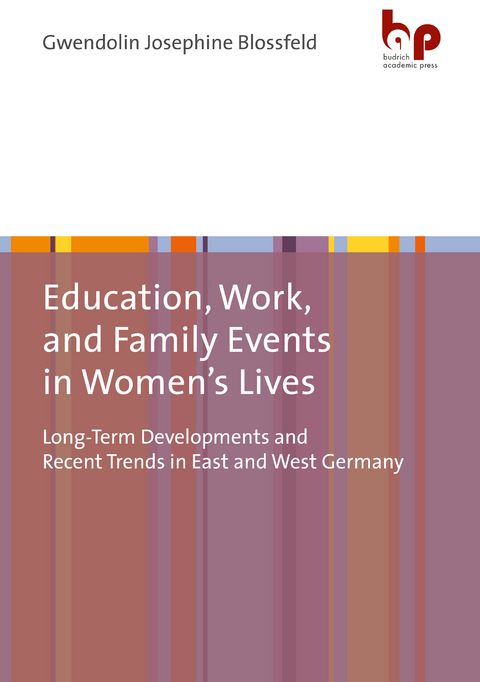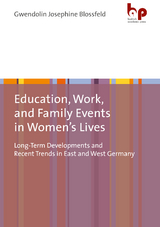Education, Work, and Family Events in Women’s Lives
Barbara Budrich Academic Press (Verlag)
978-3-96665-047-2 (ISBN)
Dr. Gwendolin Josephine Blossfeld is a postdoctoral fellow at Otto-Friedrich-Universitat Bamberg, Germany.
1 Introduction
1.1 Contributions of the Book
1.2 Outline of the Book
1.3 The Life Course Perspective
1.4 The Historical Developments of Women's Roles in Germany and Changes in Family Formation and Dissolution
1.4.1 The Preindustrial Family in Early 19th-Century Germany
1.4.2 The German Family in the Second Half of the 19th Century
1.4.3 The Age at First Marriage and the Birth of a First Child in the 20th Century
1.4.4 The Development of Female Employment Between 1882 and 1980
1.4.5 The Gain in Importance of Part-Time Employment Since the 1960s
1.4.6 Marriage, Birth, and Divorce Patterns of Women in East and West Germany
1.4.7 Summary
1.5 A Longitudinal Approach
1.6 The National Educational Panel Study (NEPS)
1.7 Event History Analysis
2 Living Arrangements and the Birth of a First Child in the Early Life Course: A Description Based on NEPS
2.1 Sequences of Partnership States Over the Early Life Course in East and West Germany
2.2 The Proportion of Women Who Have Ever Married Over the Life Course in East and West Germany
2.3 Women's Partnership Status at First Birth and the Proportion of Childless Women
2.4 Summary
63 Entry Into First Cohabitation or First Marriage: A Longitudinal Analysis
3.1 Theoretical Framework and Hypotheses
3.1.1 Union Formation Processes and Educational Expansion
3.1.2 Union Formation and the Two Germanys Before and After German Unification
3.1.3 Further Important Factors Influencing First Union Formation
3.2 Definition of Variables
3.3 Results
3.4 Summary of Empirical Findings
4 Transition From Cohabitation to Marriage: Does the Meaning of Cohabitation Differ in East and West Germany
4.1 Theoretical Framework and Hypotheses
4.1.1 The Meaning of Cohabitation
4.1.2 Different Dimensions of Time in the Analysis of Cohabitation
4.1.3 The Two Germanies Before and After Unification
4.1.4 Long-Term Change in Social Norms
4.2 Definition of Variables
4.3 Results
4.3.1 Descriptive Overview
4.3.2 Multivariate Analysis
4.4 Summary of Empirical Findings
5 Educational Homophily, Educational Homogamy, and the Impact of Mothers' Role Models on Daughters' Cohabitation and Marriage
5.1 Theoretical Framework and Hypotheses
5.1.1 Educational Assortative Mating: Do Opposites Attract or Does Like Marry Like?
5.1.2 Intergenerational Transmission of Gender Roles
5.1.3 Further Differences in Assortative Mating
5.2 Definition of Variables
5.3 Results
5.4 Summary of Empirical Findings
6 What Influences the Rate of Entry Into First Motherhood for Women Enrolled in Full-Time Education?
6.1 Theoretical Framework and Hypotheses
6.1.1 Cohort Differentiation and German Unification
6.1.2 Life Course Approach: Normative Timing and Normative Sequencing of Events
6.1.3 New Home Economics
6.1.4 Social Background
6.1.5 The Two Germanies Before and After Unification1236.2 Definition of Variables
6.3 Results
6.3.1 Descriptive Overview
6.3.2 Model Estimation
6.4 Summary of Empirical Findings
7 How Do Women's Educational Enrolment, Educational Attainment Level, Labor Force Participation, and Career Advancement Affect the Rate of Entry Into First Motherhood?
7.1 Theoretical Framework and Hypotheses
7.1.1 Life Course Approach: Normative Sequencing of Events and Fertility Pressure
7.1.2 Economic Perspectives: Forms of Investment and Employment
7.1.3 The Two Germanies Before and After Unification
7.1.4 Age Dependency, Social Origin, and Marriage
7.2 Definition of Variables
7.3 Results
7.3.1 Descriptive Overview
7.3.2 Model Estimation
7.4 Summary of Empirical Findings
88 Educational Assortative Mating and Divorce
8.1 Theoretical Framework and Hypotheses
8.1.1 Women Marrying Up
8.1.2 Educational Expansion and Assortative Mating
8.1.3 Dimensions of Education
8.1.4 A Comparison of Divorce Between Women in Upward, Downward, and Homogamous Marriages
8.1.5 Further Differences in Marital Instability
8.1.6 Definition of Variables
8.1.7 Results
8.1.8 Summary of Empirical Findings
9 Conclusion
9.1 Central Findings
9.2 Implications of Research
9.3 Limitations of This Book and Suggestions for Future Research 10 References
| Erscheinungsdatum | 21.02.2022 |
|---|---|
| Verlagsort | Leverkusen-Opladen |
| Sprache | englisch |
| Maße | 148 x 210 mm |
| Gewicht | 360 g |
| Themenwelt | Sozialwissenschaften ► Soziologie ► Gender Studies |
| Sozialwissenschaften ► Soziologie ► Mikrosoziologie | |
| Schlagworte | Bildungsbeteiligung • Bildungsexpansion • Bildungsniveau • career resources • consequences of motherhood • Dienstleistungsgesellschaft • Divorce • Educational attainment • educational expansion • Educational participation • Erwerbsbeteiligung • Familienleben • family life • historical periods • historischen Perioden • Karriereressourcen • Konsequenzen von Mutterschaft • labor force participation • Partnerschaft • Partnership • reunification of life courses • Scheidungsprozesse • Service Society • Social Origins • Soziale Herkunft • Wiedervereinigung von Lebensverläufen |
| ISBN-10 | 3-96665-047-9 / 3966650479 |
| ISBN-13 | 978-3-96665-047-2 / 9783966650472 |
| Zustand | Neuware |
| Informationen gemäß Produktsicherheitsverordnung (GPSR) | |
| Haben Sie eine Frage zum Produkt? |
aus dem Bereich




